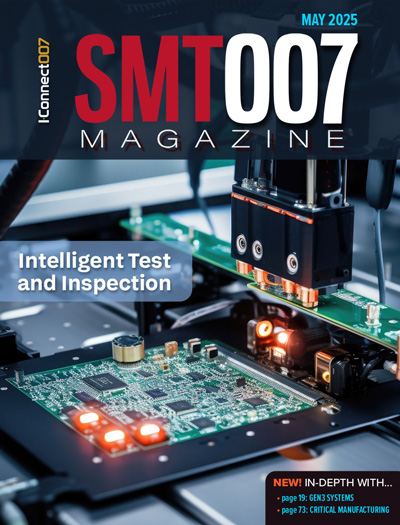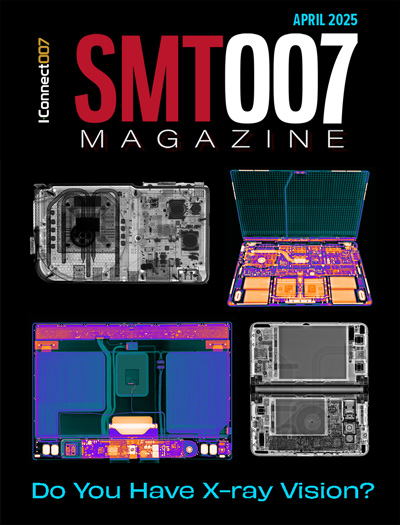-

- News
- Books
Featured Books
- smt007 Magazine
Latest Issues
Current Issue
Moving Forward With Confidence
In this issue, we focus on sales and quoting, workforce training, new IPC leadership in the U.S. and Canada, the effects of tariffs, CFX standards, and much more—all designed to provide perspective as you move through the cloud bank of today's shifting economic market.

Intelligent Test and Inspection
Are you ready to explore the cutting-edge advancements shaping the electronics manufacturing industry? The May 2025 issue of SMT007 Magazine is packed with insights, innovations, and expert perspectives that you won’t want to miss.

Do You Have X-ray Vision?
Has X-ray’s time finally come in electronics manufacturing? Join us in this issue of SMT007 Magazine, where we answer this question and others to bring more efficiency to your bottom line.
- Articles
- Columns
Search Console
- Links
- Media kit
||| MENU - smt007 Magazine
Implementation Challenges for Halogen-free Solder
December 31, 1969 |Estimated reading time: 11 minutes
Concerns about halogen toxicity have brought on reduction/elimination campaigns across the electronics industry, including the soldering materials sector. While the quantities of bromine (Br) and chlorine (Cl) in soldering fluxes are so small, they are not likely to be as detrimental as halogens in PWB flame retardants, alternatives to Br and Cl in soldering fluxes are still being sought by electronics manufacturers.
BY Timothy Jensen; Amanda Hartnett; and Ronald C. Lasky, Ph.D, PE, Indium Corporation
Flame retardants play an important role in safety, saving thousands of lives. They are used in products as varied as children’s pajamas and electronics assemblies. Some of the more successful flame retardants are halogenated compounds. Halogenated materials are found in polyvinyl chloride (PVC), brominated flame retardants (BFRs), chlorinated flame retardants (CFRs), and in fluxes used in the electronics assembly industry.
In recent years, halogen-containing compounds have been demonstrated as environmentally unfriendly. For instance, in some applications, halogenated flame retardants (HFRs) in plastic materials can release corrosive and toxic gases if ignited in a fire. The corrosive element of these gases has the potential to damage electronics wherever the smoke travels. The toxic element is potentially hazardous to human and animal life.

Trace amounts of halogen-containing compounds have been found in humans, wildlife, and the environment. These concerns have brought halogen reduction and elimination to the forefront by environmental organizations. Electronics manufacturing companies have an opportunity for halogen reduction in fans, connectors, PCBs, sockets, and power cords. PCBs, connectors, and sockets represent the largest halogen reduction opportunity.1
While Br and Cl in soldering fluxes are likely not nearly as detrimental or harmful, alternatives in soldering fluxes are sought by major electronics companies. In light of this situation, we will focus on how to be successful in implementing halogen-free fluxes and solders.
A halogen is simply one of the elements in Group 7 of the periodic table of elements: chlorine, bromine, fluorine, iodine, and astatine. Therefore, to be halogen-free, a product must not contain any of the above elements. By definition, a halide is any compound containing a halogen. Table salt (NaCl), for example, is a halide. By strict definition, halide-free would mean a product does not contain any halogenated compounds. However, that is not exactly how the term is used for soldering fluxes. A flux that is classified as halide-free by the IPC/J-STD-004 is actually only free of ionic halides.
The difference between these terms is critical because those seeking halogen-free electronics should not assume that a halide-free flux complies with their halogen-free requirements.
Classifying fluxes based on their halide content is not a new concept. IPC and other standard-generating bodies such as IEC and JIS classified electronic soldering fluxes for decades to determine their potential corrosiveness if left uncleaned on an electronics assembly. The classification method categorizes fluxes as L, M, or H based on their level of corrosiveness. In addition, fluxes are rated for halide content as 0 or 1.
Halide ratings date back to the 1970s and 1980s, when use of certain highly corrosive activators was a cause for concern. These were detectable by simple, still-in-use tests, including the copper mirror test, the silver chromate test, and titration.
Pushing toward green technology, the recent initiative to focus on halogen-free materials was kicked off by the PCB standard IEC 61249-2-21:2003. The reason for this initiative is clear: PCBs are among the greatest offenders when it comes to halogen-containing additives. This standard defined a halogen-free product as one containing ≤ 900-ppm bromine, ≤ 900-ppm chlorine, and ≤1,500-ppm bromine and chlorine cumulative.
The restrictions did not remain isolated to the PCB arena. Previous to the IEC standard release, J-STD-004 required that a flux be less than 500 ppm of total halides (Cl+Br+Fl+I) to be classified as L0 (term often used synonymously with halide-free). The test method for halide content specified by J-STD-004 is either titration or ion chromatography (IC). The challenge is that only ionic halides are detected with these methods.
Many fluxes today contain halogens as part of their activators that aid in oxide removal. However, they are usually in the form of covalently bonded halides. These halides are much more stable than ionically bonded halides and provide fluxes with better electrical reliability when used in a no-clean application. Covalently bonded halides are not detected when tested by titration or by ionic chromatography. Therefore, L0, or halide-free per J-STD-004, is not necessarily halogen-free.
 Figure 1. Dendrites
Figure 1. Dendrites
Since many modern fluxes are no-clean varieties, their residues remain with the finished product and must be compliant with halogen-free specifications. This implies that the flux is evaluated post-reflow. Post-reflow testing is not universally accepted, however, as reflowing the material makes testing more difficult and adds variables that may affect results. Factors such as reflow profile and location/thickness of the scraped flux residue could impact the halogen content. Tables 1 and 2 show the halide readings of one flux tested pre- and post-reflow.
The halogen content between the two measurements is different. After reflow, the halogen content appears higher because all of the solvents in the flux have volatilized. Therefore, if you are interested in halogen content of the final assembly, you will want to analyze the halogen content in the flux residue.
Silver Chromate Paper Test (J-STD-004; TM-650 #2.3.33). One of the early halide-detection techniques was the silver chromate paper test. This is a qualitative test in which a sample of flux is applied to silver chromate paper and allowed to remain for one minute. After removing the flux, a paper color change indicates the presence of Cl or Br. This test only identifies halide in the ionic form and is prone to false positives from chemicals such as amines, cyanides, and isocyanates. It also provides no indication to the presence of halogens.
Titration (J-STD-004; TM-650 #2.3.35). Titration is not used as commonly as it was 20 years ago, due to the availability of more advanced analytical methods; however, this was once the most common quantitative halide measurement technique. The halide measurement is reported as a Cl equivalent. A flux or flux extract is titrated to its endpoint following the J-STD-004 procedure. This test method is an improvement over the silver chromate test in that it provides a value for how much halide is present. However, it also is affected only by ionic halides. In addition, there are a variety of organic chemicals that can be falsely identified as halides.
 Table 1. Halide content pre-reflow. Anions by ion chromatography. Sample weight 0.5 grams.
Table 1. Halide content pre-reflow. Anions by ion chromatography. Sample weight 0.5 grams.
Ion Chromatography (J-STD-004; TM-650 #2.3.28). Ion chromatography is the only quantitative test currently available that can identify the total quantity of halides present in a flux. Measurement is based on the retention time in the ion exchange column. The data output is a chromatogram, which appears as peaks representing various halides. The chromatogram is read by comparing it with previously developed standards. This test method allows one to quantify the entire halide presence and the quantity of each halide element.
Ion chromatography, when used alone, only identifies the ionic variant. The bonds in covalently bonded halides are more difficult to break and are not detected. In addition, there are chemicals that have similar retention times to Cl- and Br- that can result in non-halides being misidentified as halides.
The practice of running ion chromatography on reflowed flux residue is growing. This technique can more accurately detect halides in the flux because some of the covalent bonds may have been broken through the reflow process.
Oxygen Bomb Combustion Followed by IC (EN 14582). Ion chromatography preceded by oxygen bomb combustion is a more accurate way of testing for the presence of halides as all halide forms are detected, both ionic and covalent species. This method involves subjecting a sample of flux (max. 1 gram) to an oxygen bomb combustion in which all of the organic material is burnt off at high temperatures. Halogenated compounds are converted into fluoride, bromide, or chloride ions. The remaining ash consists of the halogens and other inorganic materials and is dissolved into an absorption solution. That solution is then run through ion chromatography in which a true reading of the halide content can be determined. All halogen bonds, including any covalently bonded halides, are broken through the oxygen bomb process and are detected by ion chromatography unless insoluble in the absorption solution.
Using the C0 = (Ccom × Vcom × DF)/ W0 formula, the oxygen bomb combustion and ion chromatography analysis calculates the total halogen content in the flux in units of micrograms per gram (ppm) of flux.
- C0 = concentration of element in sampleCcom = concentration of element in combustateVcom = total volume of combustate, mLDF= dilution factorW0 = weight of sample combusted, g
This quantitative test method is gaining popularity across the electronics industry.
Since the flux residue left on the PCB is the concern when targeting halogen-free requirements, that is what should be assessed through the oxygen bomb test. There are several ways to go about testing flux residue.
One method would be to scrape the flux residue from a reflowed PCB. In theory, this would provide the most realistic numbers relative to halogen content on a finished electronics assembly. However, the scraping process could remove some solder mask and FR-4 from the PCB, altering results.
To avoid a PCB contamination issue, the flux or solder paste can be reflowed in an aluminum dish. The residue scraped from the dish could be run through oxygen bomb testing. However, variations in reflow profiles could affect results. For example, the halogen content for a sample reflowed at a peak temperature of 230°C may be different than when reflowed at 260°C.
 Table 2. Halide content post-reflow. Anions by ion chromatography. Sample weight 0.5 grams.
Table 2. Halide content post-reflow. Anions by ion chromatography. Sample weight 0.5 grams.
As an alternative method to reflowing the flux, run a calculation based on the halogen content of the raw flux. It is safe to assume that none of the halogen will volatilize. In addition to oxygen bomb testing the raw flux, conduct a thermogravimetric analysis (TGA) that simulates all of the reflow profiles in which this flux or paste would be used. A TGA helps determine weight loss relative to temperature. This would allow a single oxygen bomb halogen test to be conducted and the results correlated to any profile. For example, if the oxygen bomb and IC results show 450 ppm of Cl- and the TGA shows that the flux volatilizes 50% during reflow, you can determine that there will be 900 ppm of Cl- in the flux residue.
Across the electronics industry, including the soldering materials sector, there is an overwhelming push for products to be halogen-free. The main concern with halogenated materials is their environmental impact; a second concern is their corrosion potential. This is becoming crucial as IC geometries shrink and package sizes and I/O counts grow. With these trends, there is an increased potential for failures resulting from corrosion and dendritic growth.
When halogenated materials, including solder fluxes, come in contact with moisture, chemical reactions can turn halogenated compounds into free radicals. These radicals can be detrimental to the circuitry of micro-sized packages. Free halides corrode metals in moisture but may also impact stability and shelf life of solder paste prior to use.
Considering corrosion concerns, the switch to halogen-free products seems logical. With soldering fluxes, though, the issues do not disappear when the halides are removed. Old issues are addressed, but new ones emerge.
Formulating new halide-free fluxes is not simple. They require a higher mass percentage of halide-free activator to perform the same functions as their halogenated alternatives. With all the added activators, there is less room for other flux constituents (i.e. rheology-controlling chemicals).
Once you select a solder paste or flux that is actually halogen-free, the next step is to implement the material into a PCB assembly process. The industry is in the middle of a major transition from tin/lead to lead-free materials, creating new challenges for solder pastes and fluxes. With the growing emphasis on halogen-free requirements, the PCB assembler must be extremely diligent in assessing their materials.
Halogens are used as part of the activator package in fluxes because they are especially effective at oxide removal. Halogen-free alternatives do exist, but there are potential trade-offs. Since a solder paste flux is a complex mix of rosins, solvents, activators, and rheological additives, switching to a halogen–free material can affect performance beyond soldering. Halogen-free activators are not as effective at oxide removal; therefore, to obtain equivalent wetting and coalescence, more activator is needed. To offset this, you may need to compromise on the rosin or rheological additives, potentially compromising the SIR performance, printability, or stencil life. Figure 1 shows a halogen-free flux that caused dendritic growth. This illustrates why it is essential to critically assess all performance and reliability attributes beyond the soldering performance of halogen-free solder pastes.
In a wave solder flux, desired material attributes are different than with solder pastes. Generally speaking, an assembler wants a material that provides excellent hole fill with minimal residue left on the bottom of the board. Because a halogen-free material will likely require more activator, it may be necessary to add other solids to ensure that the residue is benign and passes SIR and electromigration requirements. Added solids can affect in-circuit testing and may not be cosmetically appealing.
This is a time of an extraordinary change for the electronics industry. Although incremental material changes are expected over time, the simultaneous drive toward green products that are both lead- and halogen-free is a revolution with far-reaching challenges and potential repercussions.
Design and implementation of lead- and halogen-free solders must be handled with care to ensure their reliability. These cutting-edge materials and their true halogen content must be diligently assessed to ensure they are what they say they are and they perform the way they are designed to perform. SMT
REFERENCES:
- Aghazadeh, M. “Halogen Free...A Global Perspective,” Intel Halide Free Symposium, 2007.
Timothy Jensen; Amanda Hartnett; and Ronald C. Lasky, Ph.D, PE, Indium Corporation, may be contacted at tjensen@indium.com, aharnett@indium.com, and rlasky@indium.com, respectively.


